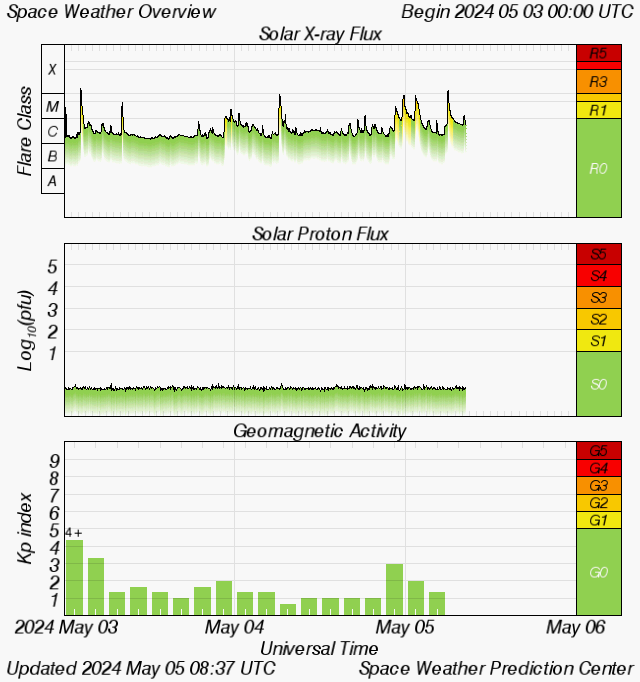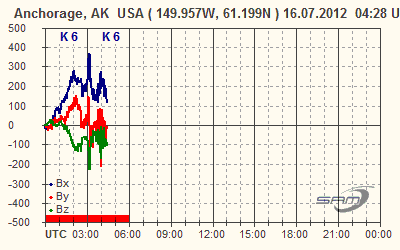Part 4:The Showdown - Watching for the illusive lights
In reality it may take several hours before the conditions for aurora truly set and now-a-days I leave the trip out till the last moment. Pin pointing the best time to head out is helped by going back to the Space Environment Centre web site and watching the this Plot on the left. Clicking on the GOES hp graph opens a window with better detail. When I see the blue line drop rapidly below normal, it is a good time to get moving as the aurora is most likely to be seen on the upswing. As our night fall coincides close to the bottom of the cycle any major movement below 50nt is enough to get me excited and rushing out the door. The power of the Aorora is shown by the bars at the bottom. Typically the aurora would be visible in Canterbury NZ when the kp is 6+ and overhead when 8-10.
This here is a typical pattern for a successful event on 7-8 November 2004
Note how it can take up to half a day after the first shock before speed develops and powers up this huge aurora. Just as well this time as the event was mostly during the day. Great for the other side of the world in with dark skies, but it held on for our evening only to be obscured by cloud. Another great opportunity ruined.
Here is a larger view of the earths magnetic flux (GEOD hp) under the shock - as measured by two weather satellites.
Despite such encouraging signs, strong magnetic disturbances still may not drive the hottest aurora. They simply may not impact head on or even nudge the earth's field at the right angle or with the right timing. This is like when to push a pendulum and which way to get a really big swing.
For our latitude I find just a good old isolated M class flare will often do a better trick, especially if it is one of long duration. I think of this like seeing a flag in the wind: a steady wind and big undulating waves flow along the cloth; a stronger wind and the flag tightly ripples and freezes.
An interesting development is a worldwide network of SAMs (Simple Aurora Monitors) to detect changes in the earths magnetic field. I figure this one in Alaska is likely to give more acurate information for detecting auroras here in New Zealand, being on the same side of the earth. It is tempting to buy a kitset and install it locally for the network. (My problem is to find a location away from stray electrical fields) Below is a monitor from Sweden for comparison.
Better still, I am wondering this free app is going to prove to be a very inexpensive magetometer for Apple fans. Since iPhone 3GS/iPhone 4 IPod and Ipads include a compass, this magnetometer can measure interferences caused by all sorts of things including magnetic storms.
Radio Detection
Recently, it has occurred to me that radio buffs must have a few clues about auroras as they hugely affect radio transmssions. I have yet to learn much about this but figure that it must be possible to hear the aurora coming long before it can be seen. DXrobot seems to be onto this and have American and European alert systems via Email, Mobiles, and even Twitter. This should also serve well for Southern Hemisphere events.
| VHF Aurora : | |
| 144 MHz Es in EU : | |
| 70 MHz Es in EU : | |
| 50 MHz Es in EU : | |
| 144 MHz Es in NA : |
| From The DXrobot |
| Today's MUF & Es : |
| From MMMonVHF |
A typical 'sub-storm'
If we think of the whole event as a storm then within in this there is likely to one or more surges away from the poles. Because of the magnetic currents, each surge will have areas of local intensity known as sub-storms.
 |
| Approaching arc of the Aurora Australis - Adair near Timaru, New Zealand. - Photography by Geoff Cloake |
From my latitude you would first see a pale green eerie glow to the south brightening, as it approaches. A crest of a dull arc will rise above the horizon and thicken. And that may be all!
If lucky, the odd shaft of pale light may reach and scan the lowest stars in the far distance. The glow may retreat or hang around for nights on end.
 |
| Rays forming the crowning arc of the Aurora Australis - Adair near Timaru, New Zealand. - Photography by Geoff Cloake |
If the sub-storm has enough power (and we are talking gigawatts here - like multitudes of power stations) it will continue forward and at it's furthermost advance, suddenly break out into a crowning glory, a multitude of sweeping rays forming radiant multicoloured curtains across the sky lasting for up to half an hour before breaking up into what is known as the decaying phase. Later I was to learn this was the most Powerful X-ray event ever observed.
 |
| Arc of the Aurora Australis passing overhead - Home Station near Timaru, New Zealand. - Photography by Geoff Cloake |
Occasionally you may see swabs of luminous light dab the southern sky or it may pulsate with enormous swishes of light rapidly running up from some tiny place, bursting apart to disappear far and wide in the ever ness overhead.
Only once on May 2005, and when least expected from a M8, did I see an arc go fully over head and watch it break into huge blobs of neon green floating silently North.
 |
| Rays combining into flowing curtains of the Aurora Australis - Adair near Timaru, New Zealand. - Photography by Geoff Cloake |
Coming up behind was another wave this time already a broad wall of red covering half the sky. I just couldn't take it all in and stopped trying to photograph it. It was all so large I had no lens that could take it all in.
Then bright red rays went overhead, penetrating up into an inconceivable space, dispersing way up there somewhere among the stars. Clouds forced a drive towards the hills and again no photo could ever convey the experience. I simply put it a way, gazed and gazed, with no further thought.
Finally, someone can't have paid the power bill and there was sudden darkness.
The nature of substorms is becoming better understood as a result of Themis, Nasa's five satellite mission to investigate substorms over North America in conjunction with 20 ground cameras.. This video gives a very clear idea of the wildly random nature of sub storms.
How long to wait?
If I am having difficulty when the event is underway I find a another good real-time indicator of shock wave results is this OVATION test simulator by NOAA showing where the extent of the aurora is reaching.
By observing the rotational lag and 'cam' nature of the of the oval centered over the magnetic pole I found auroras would have to be more much more powerful to reach my latitude just before midnight. There being less chance I find I have less argument with myself to stay out all night in vane hope. Probably a very good thing!
This is what has just been happening with the Southern Hemisphere statistical oval extrapolated from NOAA-15.
You can have this graphic added to your Google Earth as a layer by using this link from the Space Weather Prediction Centre
And this is what it looked like at 9:44 UTC on November 8 2004 when pumping a heavy flow of 406 GigaWatts. One of the great shows and and most of the South Island went under cloud.
No show still a show?
If after all this the weather packs up it's nice to go home and watch this auroracam in located at Kiruna, Sweden, which s very good at showing the trend of the Aurora in the Northern Hemisphere and as there is some mirroring effect with the south, it serves as a good indicator of what is happening down here too. AuroraMax is another fine example from a way up north in Yellowknife Canada.
And if the photography fails others will post their successes (and many other 'space things') on the Space Watch gallery.
Also if the show is rolls out to be a dud, there is always a shooting star or satellite to be seen and the time spent musing over the stars has aroused so much interest in astronomy, I now have my own 'virtual' planetarium on the notebook computer to assist my learning.
Learn for the next time
That said, they believe Aurora predictions are more reliable that weather predictions. Going by the above model of the earths magnetic from the Japanese Space Environmental Service (NiCT) site it does seem possible. It is certainly helping my understanding by showing an amazing simulation as the event happens. .
I have also found the Solar Activity Comparison Plots by the Geophysical Institute here useful in studying the outcomes of various solar storms. The sporadic occurrences also help us understand why they can be so elusive.
Recap
This video is an enjoyable way to recap how the Northern Lights come to be as seen from the sun, space and Earth using live footage and 3-D modeling set to music by Alexa Sunshine Rose.
Enjoy the work of other Photographers
There are a few incredible aurora photographer's I aspire to and whose websites I visit to buck up my ideas from time to time. I don't know if any attempt to emulate them helps the soul though. Here is LeRoy Zimmerman's Spacewatch Gallery from Alaska. They are truly amazing.
World Wide Interest
As well as website visiting and emails forums I sometimes I join internet chat rooms, to swap enthusiasm and ideas along with website links. In all - join a world-wide community of buzzing people clambering to vantage points to see skies of blooming colour.
Next I guess auroras will be getting TV coverage with commentator opinions and speculations over the real time simulator interspersed with, world-view snatches of events and even action replays.
So be it!
More images and my stories about pursuing the Aurora are here.
 |
| Southern Lights over Jack's Point, from Patiti Timaru - Photography by Geoff Cloake |



















